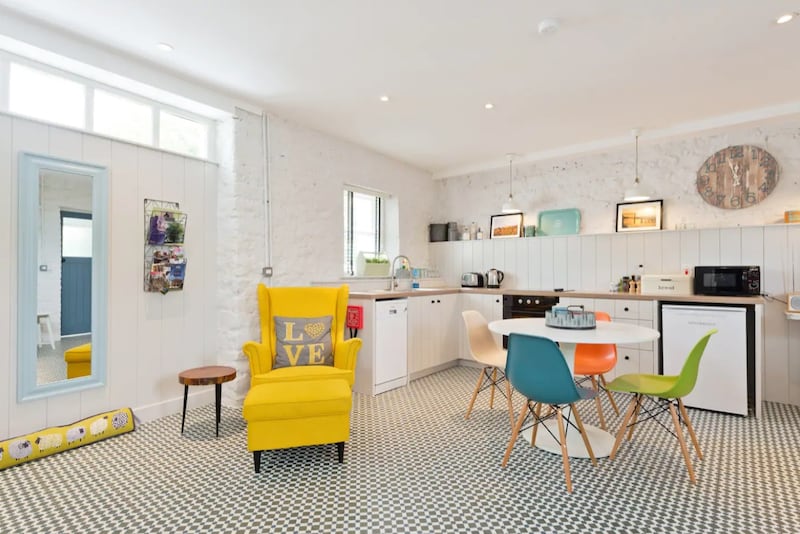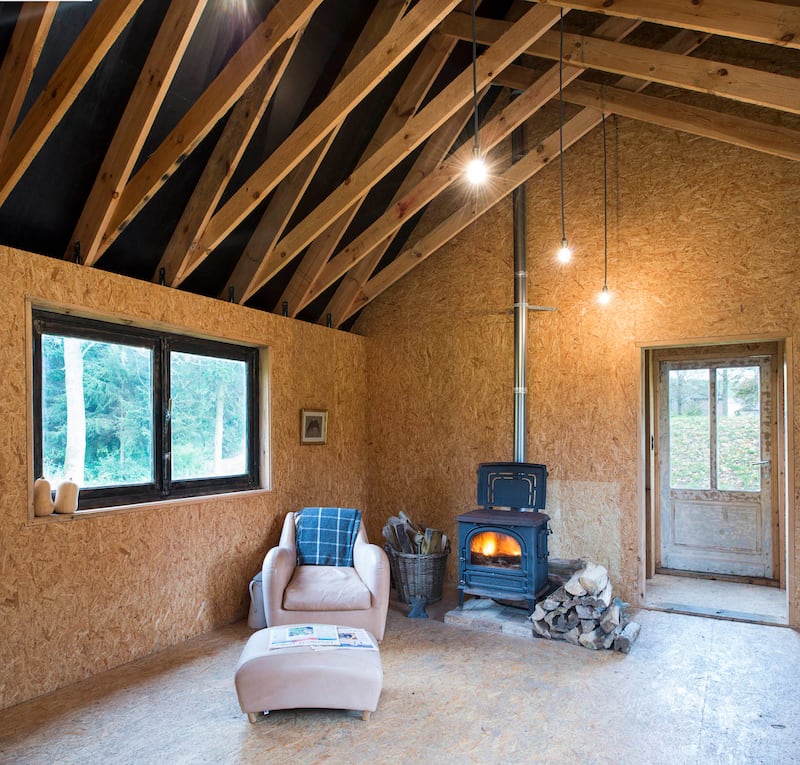Ireland’s countryside is littered with farm buildings, some returning to the land, others still proudly wearing whitewashed walls, their beautiful arched roofs of corrugated-steel sheeting having weathered to a glorious russet red.
These dwellings often sit into their surroundings in a way that modern one-off builds do not, and echo the curves of the surrounding hills and valleys. Their rustic forms offer a sense of scale that most suburban city homes can’t come close to.
And yet, compared with rural parts of Britain, France and Italy, conversions remain relatively rare here. That many are situated close to the main farmhouse, whose owners may require right-of-way access, and that you may need planning permission to convert such a building if it is listed, are indeed complications, but for families who already own such properties there is an income opportunity from short lets.
That had been Kevin O'Neill's plan. The architectural technologist, who works with OMP Architects, renovated a disused building on the family farm on the edges of Ballyjamesduff, a town in Co Cavan immortalised in song by Percy French in Come Back Paddy Reilly.
The double-height stone building with a hayloft above was built of fieldstone, a term used for local stones found lying about the area, but mainly limestone, he explains.
He wanted to maintain the barn's ceiling heights, which in the open-plan living area extend to about 5.5m, and to make the interior look like a New York loft, so he chose a tumbled brick by a local company, Kingscourt Country Manor, for its warm-pink colour and variance for internal use.


A big problem with such buildings is that, while they exude rustic charm, they are often also damp and cold and don't feel at all homely. He resolved this issue by internally insulating the stone walls using an Isover Optima dry-lining system that in effect creates a house within a house, he explains, something that you can do in a building with such lofty proportions, for you lose about 10cm from each wall and roof.
The upside is that the investment turns the property into a toasty A2 BER-rated building. The system also gave him the flat plastered interior walls he wanted and allowed him to conceal all the plumbing and electrics behind them.
His only other addition to the original structure was a box-like porch to the front that takes you into the open-plan, L-shaped livingroom-cum-kitchen, and hatch-style Rationel Aura Plus powder-coated-aluminium hatch-style windows in Ral colour 7021, an anthracite grey.
The kitchen, made by his brother-in-law of Sheelin Kitchens and Carpentry, has oak butcher-block-style countertops, set in a peninsula shape, and is painted an olive green, a Dulux Paints heritage colour called Stone Green.
In total the ground floor measures about 95sq m, with another 17.5sq m at mezzanine level. A huge rolled-steel joist supports the mezzanine level, accessed via steel steps and balustrading fabricated by John Clarke.
The bedrooms are all downstairs, and there is a further 48sq m of space that he has yet to refurbish.
O’Neill loves the finished property so much that he now uses it as a weekend retreat and has shelved his plans for holiday rents.
Connell’s Barn
Restoration work will take twice as long as you expect, says furniture designer Karla Piner, who bought Connell's Barn and its adjoining thatched cottage on the green in Duleek, Co Meath. The cottage, which is the oldest house in the village, dates back to 1690, the year of the Battle of the Boyne. It had been for sale for some time, its protected structure having put other buyers off.
It will also cost more than you had anticipated. “The only way to make the refurbishment viable was to offer the cottage and the barn as two separate short-term lets.”
Piner got a small grant towards thatching the cottage. But the adjoining barn’s cob walls were bowing out, and she had to install steel supports that helped to stitch it back together, using metal staples.

She added windows to the back, to let in more light, and installed a staircase and a mezzanine to add a bedroom and en-suite bathroom. Steel beams replaced the timber joists, but cast-iron guttering and downpipes, along with reclaimed slates, lend an air of authenticity to the place. New timber sash windows were fitted, with thin glazing to make them look more authentic.
Inside, the walls took an age to dry out, and a lot of the original plaster had crumbled away. Instead of completely replastering the interior she has kept the walls as they were, leaving the stone exposed, which helps to create a sense of heritage in the otherwise bright, clean space. The walls have been limewashed, and colourful furniture catches the eye while photographs of nearby landmarks and prints from Jam Art Factory lend local flavour.
Piner made a few mistakes. The main one, she says, was to reinstate the timber barn doors to the front. They looked great but leached heat, so their function is now merely decorative – inside, a panelled half-wall stops the heat loss while still letting in the light from the glazing above the doors.
Providence House
A barn can also be a place to escape the everyday. The owners of Providence House, a fine four-bedroom country house on the River Boro, outside Enniscorthy in Co Wexford, converted their stone granary into a beguiling space for their grandchildren to use.
They restored the double-height building, filling in its one open wall but elsewhere maintaining its fine exposed stone and brick window surrounds. The existing steel window frames were glazed, and their wood lintels retained. The A-frame timber beams are also original, but supporting steel beams have replaced the original timber joists, which had rotted. Underfoot they laid a concrete floor and screed. It has been painted a restful cornflower blue using hard-wearing floor paint.


The space, which is warmed by a wood-burning stove, could be further extended, as one-third of the barn has been converted into a garage and could allow for bedrooms and bathrooms to be added to the existing space. Situated at right angles to the main house, its Insta-friendly interior could offer the next owner a short-let income, subject to planning permission. The property, including the barn, is asking €750,000 through Savills.
Its head of country agency, James Butler, has noted a growing demand for such buildings, be it for use as retreats, cookery schools or working from home – if there is decent broadband.
One such successful restoration project is Monalea, a barn on the Wicklow-Wexford border that is used as a yoga retreat. The light touch of conservation architects and husband-and-wife team Antonello Vagge and Suzanne MacDonald, of MacDonald Vagge, has allowed its original features to sing.
Timber floorboards run the length of the building, with four bedrooms set at the far gable end, two at entrance level and another two at mezzanine level. The open hearth has a square concrete surround, and additional light is diffused through roof lights hidden by the timber rafters.

Insurance is another problem, as Byranna Young, who runs the Old Deanery in Co Wexford, discovered when she went to refurbish its barn building, one of several that she rents to groups of up to 27 for family get-togethers and group weekends away.
The property dates back to 1735, decades before the pikemen took up their arms in the 1798 rebellion. Ecclesiastical Insurance, a firm that insures old churches, was the only company to offer cover.
She replaced its corrugated roof with a slate one, installed some Velux roof lights, whitewashed the walls and insulated the ground, installing a sprung-timber floor and timber beams to maintain its rustic look. “It’s pretty simple,” she admits. The kitchen and bathroom are in the property’s other farm buildings, the pig house, the cow house, the hen house, duck house, sheep shed and stables, all of which have been turned into holiday cottages. Prices start at €3,000 for a two-night self-catering stay. Add-on options include catered meals and vintage tea parties operated by Oh So Sweet.
If you decide to take on such a project you need to be pretty hands on, says Kevin O’Neill. As well as spending his weekends on site, he made much of the furniture, including the TV stand, constructed using two layers of birch ply glued together, with its legs screwed to one of the layers, and the frames of the bench seating and the dining-table frame. The seats and tabletop were constructed from old pitch pine boards.
Four expert tips
Farm to fork Farm implements used decoratively can help reinforce a property's heritage. A pitchfork and spade hanging above House of Bath storage boxes adds a local flavour.

Let ceiling heights soar One of the attractions of a barn is its lofty ceiling heights. It is rare to be able to enjoy such space above your head, so make the most of it, as Noji Architects demonstrate in this schoolhouse property.
Show off stone and timber A barn's timber and stone original features are part of what make it feel so special. To make a feature of them in the bathroom, you could use accessories by Nordic House.

Decent heating is essential The London-based architectural firm De Rosee Sa created this interior for a lakeside cabin in Belgium, using an oriented strand board to help tie the timber studwork together. Its trussed scissor rafters are left exposed, and the wood-burning stove was salvaged.



















